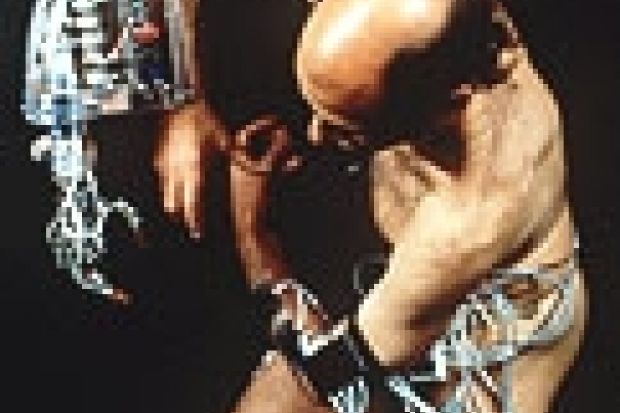Tony Tysome reports on the performance artist trying to extend the horizons of robotics
An opportunity to witness science and art working together is still something of a rarity, despite a growing trend towards interdisciplinary research. The spectacle of a man and a robot joined together and interacting in a live "dance" on stage should therefore be regarded as a research project, carrying greater significance than its novelty value alone.
Certainly there is a serious research intent behind the Sci-art:Bio-robotic Choreography project, which is aiming to achieve this feat by next year through the combined efforts of world-renowned robotic performance artist Stelarc and scientists at the University of Sussex.
Stelarc (his legal name for 30 years, from his original Greek name Stelios Arcadiou) is principal research fellow at Nottingham Trent University's digital research unit. He is leading the artistic side of the Wellcome Trust-funded project while Inman Harvey, of the school of cognitive and computer sciences at Sussex, is heading the science team.
The robot under construction is a more advanced version of Exoskeleton, which Stelarc had built while he was working in Hamburg three years ago.
He explained: "The Hamburg robot was like an exoskeleton that wrapped around my torso and my arms and responded as I changed position. It could walk forwards, backwards, sideways, squat, stand up, or sway on the spot. The choreography of these movements is what constitutes the performance skills."
Working with the Sussex scientists, Stelarc decided he wanted to develop a more flexible and "intelligent" robot that was less "stiff-jointed". The new machine may look like an insect but will "walk more like a dog", and will move in different directions and at different speeds depending on how the artist who is riding it positions their torso.
Stelarc and Dr Harvey are interested in the way the relationship between the robot and artist will help explore the distinction between mind and body, and the implications of this for robotics and artificial intelligence.
Dr Harvey said: "The common ground between science and art is the human condition. Within science, animals and humans have been studied in order to try to understand and duplicate them. The traditional view is that intelligence can be found in a creature's brain, while the body is the afterthought. Most robots are operated with this idea in mind.
"The other view is that a creature's intelligence can be located in every part of its body and is not controlled simply by the brain. The new robot will be based on this idea."
Stelarc added: "If you look at insects, they do not have big brains, yet they are highly flexible organisms that can respond intelligently to a complex environment, even with only a limited amount of sense. The more performances I do, the more convinced I am that people are like that, too. What I do is determined more by the complexity of my environment than by my intelligence or my body.
"So instead of seeing the human body as the choreographer and the robot as the instrument, I really see the two working together. That is how it becomes an artistic performance. I have no desire to control the machine completely - I would be delighted if it did something unexpected."
The sci-art project is the latest in a long line of experiments by Stelarc exploring the relationship between man and machine. In the past, he has worked with robotic arms attached to his body and linked himself up to the internet with electrodes to stimulate his muscles so that he could be "controlled" remotely from a computer anywhere in the world.
If that sounds a little bizarre and vaguely reminiscent of the Borg in Star Trek (cyborgs whose quasi-communist perspectives on life have won the interest of bad-boy artist Damien Hirst), Stelarc is undeterred.
He said: "The human body has always been a kind of cyborg. What distinguishes us is our ability to create artefacts, machines and language.
"We are manipulators. It is these kinds of things we are exploring. But I am not satisfied with just theorising about it. I want to experience what actually happens and then try to articulate what that means."
Find out more about the project at art.ntu.ac.uk/liveart or visit Stelarc's website at www.stelarc.va.com.au </a>
Register to continue
Why register?
- Registration is free and only takes a moment
- Once registered, you can read 3 articles a month
- Sign up for our newsletter
Subscribe
Or subscribe for unlimited access to:
- Unlimited access to news, views, insights & reviews
- Digital editions
- Digital access to THE’s university and college rankings analysis
Already registered or a current subscriber? Login
